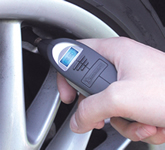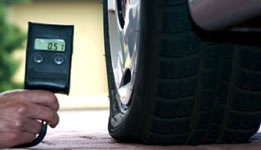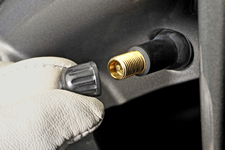 |
Everything you ever wanted to know about the humble tyre |
Level 1 - Key safety Checks Part 1 |
Tyre Pressures Check your tyre pressures once a month and before long journeys.    Ideally, check pressures when the tyres are cold; this means that they have not been used in the last 2 hours, or they have covered less than 2 miles at low speeds. If the tyres are "hot" when they are checked:
In cases of unusual pressure loss, have the internal and external condition of the tyre, the condition of the wheel and the valve checked by a tyre specialist. Recommended tyre inflation pressures for your vehicle can normally be found in the vehicle handbook or on a label fixed on the vehicle, for example on the door frame or the fuel filler flap. Use the pressures relating to your tyre sizes and vehicle load/speed conditions. Having the correct inflation pressure in your vehicle’s tyres not only optimises the performance but also increases your personal safety when driving. Driving with incorrect tyre pressures can affect a vehicle’s handling, and can seriously compromise safety—leading to incidents that can put lives at risk. If your tyres are over or under inflated enough to be considered un-roadworthy, reading this module could save you a fine of up to £2,500 and 3 penalty points per tyre. Recent results showed that:
* Michelin “Fill Up With Air” campaign data  A tyre loses some of its pressure through natural causes (typically around 1 psi (0.076 bars) per month). Pressure loss may be accelerated by other air leaks due to:
A correctly inflated tyre improves safety, is more economical in use and is better for the environment. Tyre Wear and Tread depthTyres become worn over time But this period depends on a variety of factors including driver behaviour, the roughness of the road surface, the mechanical condition of the vehicle and tyre pressure. A QUICK AND EASY SAFETY MEASURE Make sure you regularly check the tread depth of your tyres and replace them when they are worn. This will guarantee maximum traction and grip, helping you avoid any unpleasant surprises. You must change your tyres before your tread depth is worn beyond 1.6mm.
Michelin Tyre ManagerIf you are interested in keeping a track of your tread depths, Tyre Manager helps you to:-
Visit tyre-manager.co.uk What's next?In the next section, we explore what you need to know when you visit your local tyre retailer:-
|

